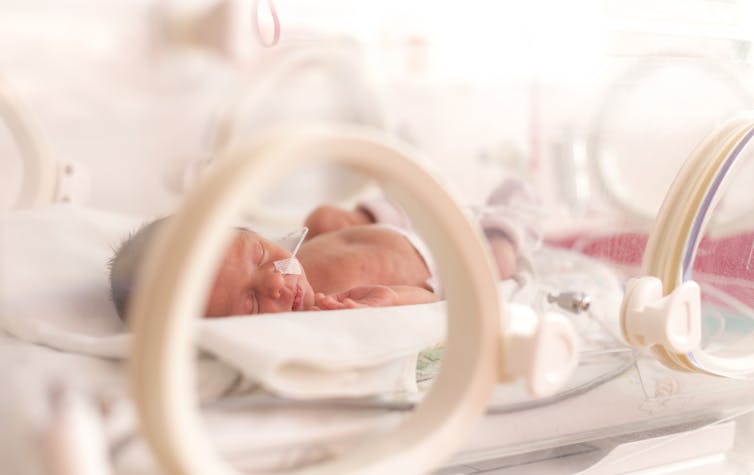Pregnant women should take extra care to minimise their exposure to bushfire smoke

Pregnant women should try to stay inside when the air pollution is high.
Smoke haze from ūŅą┬╠Ūą─VlogŌĆÖs catastrophic bushfires is continuing to affect many parts of the country.
Although thereŌĆÖs no safe level of air pollution, the health hazards tend to be greatest for vulnerable groups. Alongside people with pre-existing conditions, smoke exposure presents unique risks for pregnant women.
Research shows prolonged exposure to bushfire smoke increases the risk of pregnancy complications including , , and (before 37 weeks).
These conditions can have short-term and lifelong effects on , with increased risk of conditions including cerebral palsy and visual or hearing impairment. Even babies born only a few weeks early can experience learning difficulties and behavioural problems, and have an elevated risk of heart disease in later life.
So itŌĆÖs especially important pregnant women protect themselves from exposure to bushfire smoke.
Read more:
Why are pregnant women at higher risk?
Pregnant women breathe at an increased rate, and their hearts need to than those of non-pregnant people to transport oxygen to the fetus. This makes them particularly vulnerable to the effects of air pollution, including bushfire smoke.
We often measure poor air quality by the presence of ultra-fine particles called PM2.5 (small particles of less than 2.5 micrometres in size). These particles are concerning because they can penetrate into , and into blood and tissue to cause inflammation throughout the body.
Importantly in pregnant women, can cause to the placentaŌĆÖs blood supply. This can interfere with the placentaŌĆÖs development and function, which can in turn compromise the growth of the fetus.
What the evidence says
Many studies have linked poor air quality, particularly high , to poor pregnancy outcomes. Data from 183 countries showed in 2010, an estimated , 18% of the total, were associated with PM2.5 pollution.
A 2019 of more than 500,000 pregnant women from Colorado looked at the effect of bushfire smoke on pregnancy outcomes. The authors analysed data on air quality, fire incidence and pregnancy and birth records from 2007-2015, during which time Colorado was regularly affected by smoke from fires burning in California and the Pacific Northwest.
The study found PM2.5 due to bushfire smoke was linked to spikes in , especially in women exposed during the second trimester.
In women exposed to smoke during the ’¼ürst trimester, . Further, exposure during any trimester increased the chance of .
The effects were detectable even with low exposure to smoke and small increases in PM2.5. For every 1 microgram/m┬│ increase in average daily exposure to PM2.5 during the second trimester of pregnancy, the risk of premature birth .
To put this into context, in Canberra in the first week of January, averaged more than 200 micrograms/m┬│, compared with the typical background concentration of 5 micrograms/m┬│. EPA Victoria classifies PM2.5 levels above 25 micrograms/m┬│ as for vulnerable people.
Read more:
In another large study, was seen after 10 micrograms/m┬│ increase in PM2.5.
As well as PM2.5, bushfire smoke contains larger PM10 particles, nitric oxides, carbon monoxide and other gases and toxic chemicals. These all have potential to impair lung and heart function in the mother, activate inflammation, and directly affect fetal and placental development.
Smoke threatens fertility, too
Air quality is also a factor for couples or .
Population studies suggest air pollution compromises human fertility by reducing (the number of eggs in the ovary) and affecting and .
Direct exposure to and can also negatively impact fertility.
Read more:
Precautions to take if youŌĆÖre pregnant
The best strategy is to reduce smoke exposure as much as possible. Recommendations from include staying inside on high-risk days, sealing the house to prevent smoke infiltration and using air conditioning to keep cool.
Avoid creating smoke by cigarette smoking, burning candles, or frying and grilling. Use PM2 (N95) masks and air-filtering devices if possible, and avoid exposure to ash, which contains particulate material you can inhale.

Studies have shown when women are exposed to bushfire smoke during pregnancy, the rates of premature birth increase. From shutterstock.com
Pregnant women in a fire region should carefully follow emergency servicesŌĆÖ direction. ItŌĆÖs better to evacuate early, with an containing clothes, medications, water and food you donŌĆÖt need to cook.
Make sure your medication and prenatal vitamins are accessible, continue to take them, and stay well hydrated. Inform authorities and shelters you are pregnant and need to maintain your antenatal care.
Be aware of the including abdominal cramps or contractions, a heavy vaginal discharge, loss of fluid or vaginal bleeding, pelvic pressure and low backache. Seek help if you think you may be going into labour.
Given what we know about the consequences of poor air quality on pregnancy outcomes, itŌĆÖs critical pregnant women are given top priority when it comes to bushfire relief and health care support.
Read more: ![]()
Featured researcher
Director
Robinson Research Institute
Division of Research and Innovation
This article is republished from under a Creative Commons license. Read the .
, Professor and Director, Robinson Research Institute, and , Associate Professor and Fertility and Conception Theme Leader, The Robinson Research Institute,
